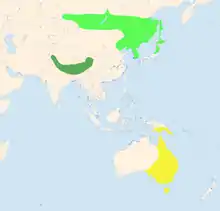White-throated needletail
The white-throated needletail (Hirundapus caudacutus), also known as needle-tailed swift or spine-tailed swift, is a large swift in the genus Hirundapus. It is reputed to reach speeds of up to 170 km/h (105 mph) in horizontal flight, but this is unverified because the methods used to measure its speed have not been published.[2]
| White-throated needletail | |
|---|---|
.jpg.webp) | |
| Scientific classification | |
| Kingdom: | Animalia |
| Phylum: | Chordata |
| Class: | Aves |
| Order: | Apodiformes |
| Family: | Apodidae |
| Genus: | Hirundapus |
| Species: | H. caudacutus |
| Binomial name | |
| Hirundapus caudacutus (Latham, 1801) | |
 | |
Northern summer Resident Northern winter | |
They build their nests in rock crevices in cliffs or hollow trees. They do not like to sit on the ground and spend most of their time in the air. They feed on small, flying insects like beetles, flies, bees and moths.[3]
The white-throated needletail is a migratory bird, breeding in Central Asia and southern Siberia, and wintering south in the Indian Subcontinent, Southeast Asia and Australia. It is a rare vagrant in Western Europe and has been recorded as far west as Norway, Sweden and Great Britain. In June 2013, an individual was spotted in Great Britain after 22 years. It later flew into a wind turbine and died; its body was sent to a museum.[4][5]
White-throated needletails are large swifts with a robust, barrel-like body. They measure about 20 cm and weigh between 110 and 120 grams. They are greyish-brown except for a white throat and a white patch, extending from the base of the tail to the flanks.[3]
Needle-tailed swifts get their name from the spined end of their tail, which is not forked as it is in the typical swifts of the genus Apus.
The white-throated needletail was first described by the English ornithologist John Latham in 1801 under the binomial name Hirundo caudacuta.[6] Their current genus Hirundapus is constructed from the names of the swallow genus Hirundo and the swift genus Apus. The specific name caudacutus comes from the Latin words cauda meaning "tail" and acutus meaning "pointed".[7]
See also
References
- BirdLife International (2012). "Hirundapus caudacutus". IUCN Red List of Threatened Species. 2012. Retrieved 26 November 2013.CS1 maint: ref=harv (link)
- Bourton, Jody (2 March 2010). "Supercharged swifts fly fastest". BBC News. Retrieved 28 October 2017.
- "White-throated Needletail". BirdLife International. Retrieved 29 October 2017.
- "Birdwatchers flock to see rare bird, then watch it killed by wind turbine". FoxNews. 28 June 2013. Retrieved 2013-06-29.
- Huyton, Harry (28 June 2013). "Let's not martyr the white-throated needletail to the anti-wind cause". London: The Guardian. Retrieved 1 July 2013.
- Latham, John (1801). Supplementum indicis ornithologici sive systematis ornithologiae (in Latin). London: Leigh & Sotheby. p. lvii.
- Jobling, James A. (2010). The Helm Dictionary of Scientific Bird Names. London: Christopher Helm Publishers. pp. 94 and 193. ISBN 978-1408125014.
External links
 Media related to Hirundapus caudacutus at Wikimedia Commons
Media related to Hirundapus caudacutus at Wikimedia Commons Data related to Hirundapus caudacutus at Wikispecies
Data related to Hirundapus caudacutus at Wikispecies- Hirundapus caudacutus in Field Guide: Birds of the World on Flickr
- "Hirundapus caudacutus". Avibase.

